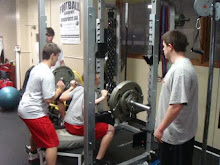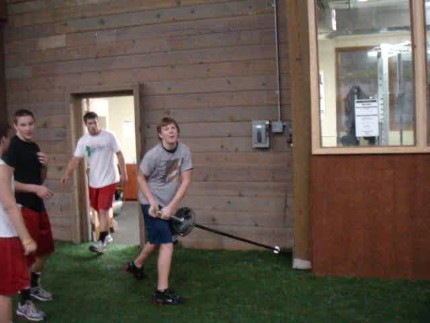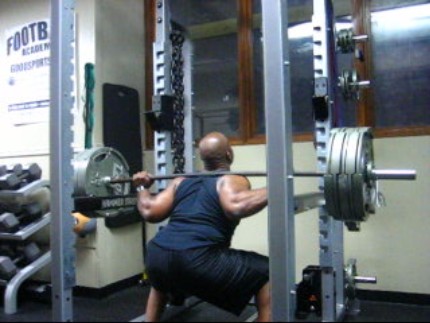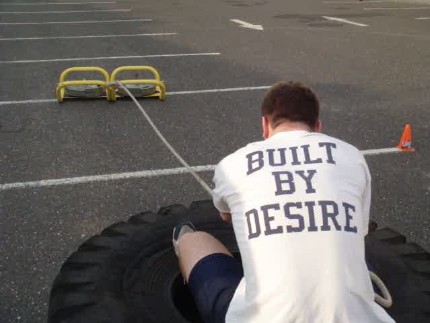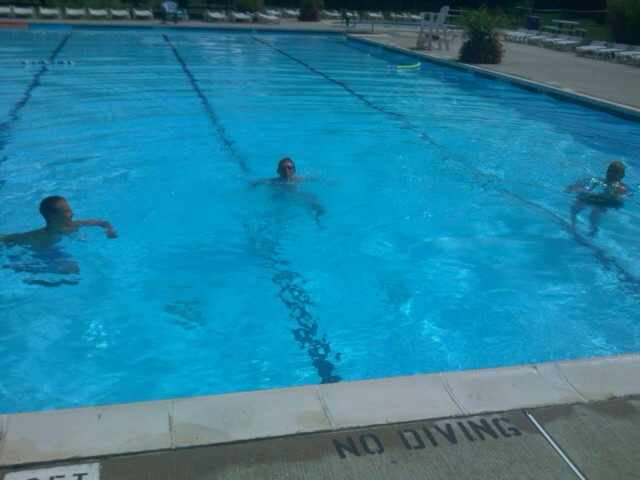JERETT SANDERSON -
Is preparing for his Pro-Day @ Bowling Green University on March 18th 2010. He has been training with me for the last 5 weeks working on all of the pro day drills (40yd dash, 225 bench press test, vertical jump, short shuttle, l-drill, broad jump & positional drills). We have been diligently working 5 days a week at making Jerett a more powerful & more efficient athlete so that he can impress as many scouts as possible. That will help increase his chances of either getting drafted into the NFL or landing a free agent spot on one of the 32 teams.
On our program Jerett has produced some fine numbers that we believe will definitely get the scouts attention.
225lb bench press test
40yd dash - 4.41
5-10-5 (short shuttle) - 4.03
L-Drill - 6.81
Broad Jump - 9'8"
Vertical Jump - 38
In addition we have Jerett seeing our Massage specialist Michelle of Balanced Body Massage 1x a week for regeneration. Jerett also participates in a weekly Yoga sessions to loosen his hips and shoulders. The yoga classes come courtesy of Cara from Synergy Hot Yoga. He is also seeing our nutritionist for instruction on how to maximize his performance for that big day.
STAY TUNED FOR MORE ON JERETT SANDERSON...HE'S A SLEEPER FOR REAL!
Here are some random training clips from our sessions.
GET STRONG BE EXPLOSIVE!!
Thursday, February 25, 2010
Wednesday, February 24, 2010
Try this quick 8 minute Cardio Workout! (NFB) Not For Beginners
I get very busy at my business training clients all day and handling all of the "other" things that go along with operating a business. Because of that I dont always have time to workout like i'd like to. I have recently been experimenting with working out 2-3 times a day but in much shorter segments instead of doing everything all at 1 time. A typical day may look something like this:
Am session: Metabolic circuits/Interval Training
Noon session: Weights (focus on the major lifts i'd like to get in). Basically I get my heavy lifting in then.
Pm session. Small points and additional cardio. I usually work the shoulders, arms & calves and get some additional rope jumping, some box jumps or finish something I was not able to finish during the morning session.
Each workout lasts approx 10-25 minutes long and is jam packed with exercising. I usually have a session or something coming up and dont have time to mess around. So these sessions are straight to the point.
Well today I experimented with a Treadmill pyramid that I wanted to share with you today. It only takes about 8 minutes and it goes like this:
Treadmill incline 6:
Speed 7.0mph - sprint 30 seconds rest 30 seconds
Speed 7.5mph - sprint 25 seconds rest 25 seconds
Speed 8.0mph - sprint 20 seconds rest 20 seconds
Speed 8.5mph - sprint 15 seconds rest 15 seconds
Speed 9.0mph - sprint 10 seconds rest 10 seconds
Speed 9.5mph - sprint 10 seconds rest 15 seconds
Speed 9.0mph - sprint 10 seconds rest 20 seconds
Speed 8.5mph - sprint 15 seconds rest 25 seconds
Speed 8.0mph - sprint 20 seconds rest 30 seconds
Speed 7.5mph - sprint 25 seconds rest 35 seconds
Speed 7.0mph - sprint 30 seconds rest -
Get your heart rate wait 2 minutes and repeat! Haha...if you dare!
If you dont have a treadmill im sure there are other thing you can substitute for the treadmill. Be creative. There are prowlers, tires, kettle bells, burpee's & or regular sprints on a field you can all substitute in for the treadmill. I happen to have one so I use it!
Caution!! If you are not in decent shape please DO NOT ATTEMPT THIS! You will end up like this!
Or this:
And may possibly need this:
So be careful!
P.S. I will post the rest of the day's workout when I am finished with the entire week. Thanks now go train!
Get Strong Be Explosive!
Am session: Metabolic circuits/Interval Training
Noon session: Weights (focus on the major lifts i'd like to get in). Basically I get my heavy lifting in then.
Pm session. Small points and additional cardio. I usually work the shoulders, arms & calves and get some additional rope jumping, some box jumps or finish something I was not able to finish during the morning session.
Each workout lasts approx 10-25 minutes long and is jam packed with exercising. I usually have a session or something coming up and dont have time to mess around. So these sessions are straight to the point.
Well today I experimented with a Treadmill pyramid that I wanted to share with you today. It only takes about 8 minutes and it goes like this:
Treadmill incline 6:
Speed 7.0mph - sprint 30 seconds rest 30 seconds
Speed 7.5mph - sprint 25 seconds rest 25 seconds
Speed 8.0mph - sprint 20 seconds rest 20 seconds
Speed 8.5mph - sprint 15 seconds rest 15 seconds
Speed 9.0mph - sprint 10 seconds rest 10 seconds
Speed 9.5mph - sprint 10 seconds rest 15 seconds
Speed 9.0mph - sprint 10 seconds rest 20 seconds
Speed 8.5mph - sprint 15 seconds rest 25 seconds
Speed 8.0mph - sprint 20 seconds rest 30 seconds
Speed 7.5mph - sprint 25 seconds rest 35 seconds
Speed 7.0mph - sprint 30 seconds rest -
Get your heart rate wait 2 minutes and repeat! Haha...if you dare!
If you dont have a treadmill im sure there are other thing you can substitute for the treadmill. Be creative. There are prowlers, tires, kettle bells, burpee's & or regular sprints on a field you can all substitute in for the treadmill. I happen to have one so I use it!
Caution!! If you are not in decent shape please DO NOT ATTEMPT THIS! You will end up like this!
Or this:
And may possibly need this:
So be careful!
P.S. I will post the rest of the day's workout when I am finished with the entire week. Thanks now go train!
Get Strong Be Explosive!
Tips For Improving Lower Extremity Postural Distortion
Lower extremity postural distortion is one of the biggest factors I face when trying to help athletes improve their performance. Time after time we see athletes with weakened glutes, tight hamstrings, tight hip flexors, internally rotated knees and everted ankles. These problems are rather common amongst many high school and college athletes, especially female athletes. The reason I mention the glute med is because that muscle in particular seems to go a long way in helping relieve lower body postural distortion in athletes. Of course it is not an cure all sort of thing. We still have to closely evaluate and assess all the functions of the lower body as well as the upper body. This gives us a general approach to add to our training sessions that allows us to address a common weakness. So we've made it our business to put together programs that not only address these issues but work to erase them totally.
The gluteus medius is a small muscle that sits atop the gluteus maximus on the outter portion of your butt (just south of you obliques). This muscle happens to be a major player in helping athletes control their femor and absorb and produce force when running, jumping or sprinting. It also is responsible for the inward and outward rotation of the hip. For years now we have addressed this muscle in the warm-up portion of our training to help "turn it on" as to involve it in the exercises to come. When the glute med is not properly activated, it lies dormant and your body will compensate in recruiting the IT bands and AB/ADductors, quads and hamstrings to do its job. What this will usually do is cause a chain effect which potentially leads to collapsing knees and eventually injury while running, jumping & sprinting.
What we've done here (at Key 2) is use different techniques to turn it and other muscles on so that the inter/intra coordination of the muscles are properly aligned. When this happens, movement is facilitated and therefore performance can improve. We've done soft tissue work with tennis/lax balls and foam rolls. We've added mini-band ab/adduction exercises, pre-hab drills like fire hydrants & knee circle variants together with planned and focused attention to proper stretching during our static & dynamic warm-up as well as during our training. Also, paying close attention to proper bending during squatting (forcing the knees out) and single leg exercises all have helped us gain an edge on conquering this deficiency.
Along with the glute med weakness is the tightness and immobility of the calf and achilles portion of the leg. Many athletes are extremely tight in their lower leg and as a result have no platform to actually produce & reduce force. Many people are not aware of how closely related the glute "deltoid" (consisting of the TFL, glute med & glute maximus) is to the lower leg. By improving the mobility of the lower leg, one can actually see an improvement in the operation of the glutes. (*So a side note - yes, addressing the foot & ankle complex as well as the hip complex can help improve the health and function of the knees). Lately we have adopted a alternate approach to activating the glute med. We have taken the calf & achilles area of the lower leg for granted and overlooked how it can have a profound effect on mobility and over all movement facilitation. Well no more.
As a result we have come up with a short list of exercises we do in order to help improve the functionality of the leg in general as well as activate the glute med. Understand that the foot and ankle muscles can actually mildly turn on the glute med. So by simply performing the exercises we're going to show next, we have seen dramatic increases in the mobility and stability of the entire leg, as well as an improvement in how our athletes are running.
Here is the simple but effective list:
1) Always start with the foam roller on the calf/achilles getting both the inner and outter portions of the leg.

Last but not least stretch the calf & achilles.
The gluteus medius is a small muscle that sits atop the gluteus maximus on the outter portion of your butt (just south of you obliques). This muscle happens to be a major player in helping athletes control their femor and absorb and produce force when running, jumping or sprinting. It also is responsible for the inward and outward rotation of the hip. For years now we have addressed this muscle in the warm-up portion of our training to help "turn it on" as to involve it in the exercises to come. When the glute med is not properly activated, it lies dormant and your body will compensate in recruiting the IT bands and AB/ADductors, quads and hamstrings to do its job. What this will usually do is cause a chain effect which potentially leads to collapsing knees and eventually injury while running, jumping & sprinting.
What we've done here (at Key 2) is use different techniques to turn it and other muscles on so that the inter/intra coordination of the muscles are properly aligned. When this happens, movement is facilitated and therefore performance can improve. We've done soft tissue work with tennis/lax balls and foam rolls. We've added mini-band ab/adduction exercises, pre-hab drills like fire hydrants & knee circle variants together with planned and focused attention to proper stretching during our static & dynamic warm-up as well as during our training. Also, paying close attention to proper bending during squatting (forcing the knees out) and single leg exercises all have helped us gain an edge on conquering this deficiency.
Along with the glute med weakness is the tightness and immobility of the calf and achilles portion of the leg. Many athletes are extremely tight in their lower leg and as a result have no platform to actually produce & reduce force. Many people are not aware of how closely related the glute "deltoid" (consisting of the TFL, glute med & glute maximus) is to the lower leg. By improving the mobility of the lower leg, one can actually see an improvement in the operation of the glutes. (*So a side note - yes, addressing the foot & ankle complex as well as the hip complex can help improve the health and function of the knees). Lately we have adopted a alternate approach to activating the glute med. We have taken the calf & achilles area of the lower leg for granted and overlooked how it can have a profound effect on mobility and over all movement facilitation. Well no more.
As a result we have come up with a short list of exercises we do in order to help improve the functionality of the leg in general as well as activate the glute med. Understand that the foot and ankle muscles can actually mildly turn on the glute med. So by simply performing the exercises we're going to show next, we have seen dramatic increases in the mobility and stability of the entire leg, as well as an improvement in how our athletes are running.
Here is the simple but effective list:
1) Always start with the foam roller on the calf/achilles getting both the inner and outter portions of the leg.
Then remove the shoes and grab a tennis ball/lax ball and roll the bottom of your feet. There are many muscles in the bottom of the foot and by activating these muscles you will turn on many of the otherwise dormant muscles of the foot, lower leg and glutes.
Make sure you get the entire bottom of the foot even the inner and outter edges.

Then stretch the sides & top of the of the feet loosening up the muscles surrounding the ankle and foot.
Last but not least stretch the calf & achilles.
Try to incorporate these exercises into your warm-up routine & you'll see a dramatic increase in your lower body mobility and running performance. The sacrifice is, a little bit longer of a warm-up but when its all said and done the results will be something you will be proud of.
Subscribe to:
Comments (Atom)





















